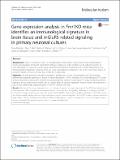Gene expression analysis in Fmr1KO mice identifies an immunological signature in brain tissue and mGluR5-related signaling in primary neuronal cultures
Author(s)
Prilutsky, Daria; Kho, Alvin T.; Palmer, Nathan Patrick; Bhakar, Asha L.; Smedemark-Margulies, Niklas; Kong, Sek Won; Margulies, David M.; Bear, Mark F.; Kohane, Isaac S.; Kohane, Isaac S.; ... Show more Show less
Download13229_2015_Article_61.pdf (2.817Mb)
OPEN_ACCESS_POLICY
Open Access Policy
Creative Commons Attribution-Noncommercial-Share Alike
Metadata
Show full item recordAbstract
Background
Fragile X syndrome (FXS) is a neurodevelopmental disorder whose biochemical manifestations involve dysregulation of mGluR5-dependent pathways, which are widely modeled using cultured neurons. In vitro phenotypes in cultured neurons using standard morphological, functional, and chemical approaches have demonstrated considerable variability. Here, we study transcriptomes obtained in situ in the intact brain tissues of a murine model of FXS to see how they reflect the in vitro state.
Methods
We used genome-wide mRNA expression profiling as a robust characterization tool for studying differentially expressed pathways in fragile X mental retardation 1 (Fmr1) knockout (KO) and wild-type (WT) murine primary neuronal cultures and in embryonic hippocampal and cortical murine tissue. To study the developmental trajectory and to relate mouse model data to human data, we used an expression map of human development to plot murine differentially expressed genes in KO/WT cultures and brain.
Results
We found that transcriptomes from cell cultures showed a stronger signature of Fmr1KO than whole tissue transcriptomes. We observed an over-representation of immunological signaling pathways in embryonic Fmr1KO cortical and hippocampal tissues and over-represented mGluR5-downstream signaling pathways in Fmr1KO cortical and hippocampal primary cultures. Genes whose expression was up-regulated in Fmr1KO murine cultures tended to peak early in human development, whereas differentially expressed genes in embryonic cortical and hippocampal tissues clustered with genes expressed later in human development.
Conclusions
The transcriptional profile in brain tissues primarily centered on immunological mechanisms, whereas the profiles from cell cultures showed defects in neuronal activity. We speculate that the isolation and culturing of neurons caused a shift in neurological transcriptome towards a “juvenile” or “de-differentiated” state. Moreover, cultured neurons lack the close coupling with glia that might be responsible for the immunological phenotype in the intact brain. Our results suggest that cultured cells may recapitulate an early phase of the disease, which is also less obscured with a consequent “immunological” phenotype and in vivo compensatory mechanisms observed in the embryonic brain. Together, these results suggest that the transcriptome of cultured primary neuronal cells, in comparison to whole brain tissue, more robustly demonstrated the difference between Fmr1KO and WT mice and might reveal a molecular phenotype, which is typically hidden by compensatory mechanisms present in vivo. Moreover, cultures might be useful for investigating the perturbed pathways in early human brain development and genes previously implicated in autism.
Date issued
2015-12Department
Massachusetts Institute of Technology. Department of Brain and Cognitive Sciences; Picower Institute for Learning and MemoryJournal
Molecular Autism
Publisher
BioMed Central
Citation
Prilutsky, Daria, Alvin T. Kho, Nathan P. Palmer, Asha L. Bhakar, Niklas Smedemark-Margulies, Sek Won Kong, David M. Margulies, Mark F. Bear, and Isaac S. Kohane. “Gene Expression Analysis in Fmr1KO Mice Identifies an Immunological Signature in Brain Tissue and mGluR5-Related Signaling in Primary Neuronal Cultures.” Molecular Autism 6, no. 1 (December 2015).
Version: Final published version
ISSN
2040-2392